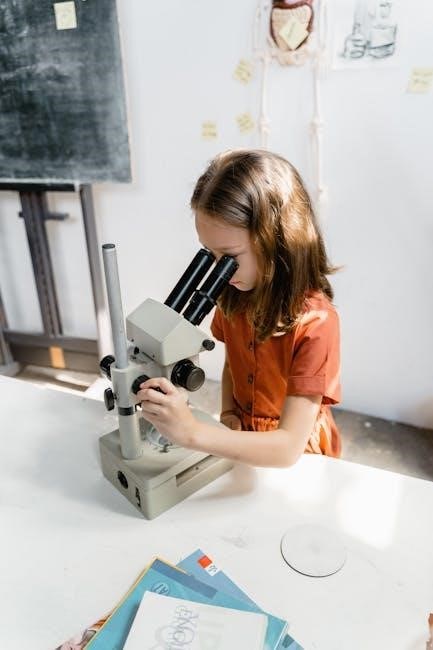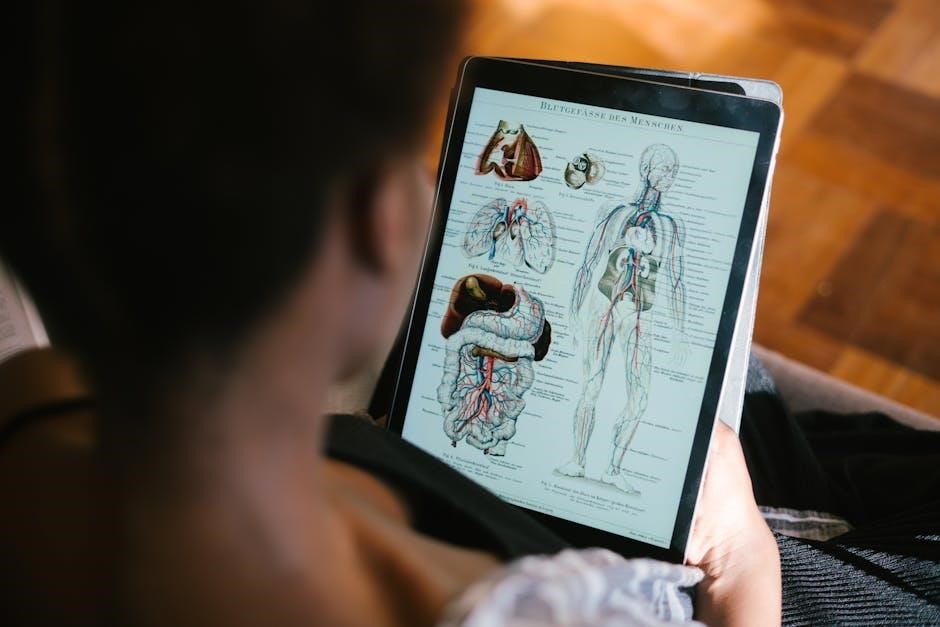Cell Structure and Function
Understand the differences between prokaryotes and eukaryotes, focusing on cell membranes, organelles like mitochondria and chloroplasts, and their roles in cellular processes. Study how cells maintain homeostasis, transport materials, and communicate internally and externally. Key concepts include the structure of the plasma membrane, passive and active transport mechanisms, and the functions of the nucleus, endoplasmic reticulum, and ribosomes. Review cell division processes, including mitosis and meiosis, and their significance in growth and reproduction. Familiarize yourself with the cell cycle, including interphase, prophase, metaphase, anaphase, and telophase, and the role of checkpoints in ensuring proper division. Understand the importance of ATP as the primary energy currency of the cell and how it is produced and utilized. Explore the role of lysosomes in digestion and recycling cellular waste. Study the differences between plant and animal cells, including the presence of a cell wall, chloroplasts, and vacuoles in plant cells. Understand the structure and function of the cytoskeleton, including microtubules, microfilaments, and intermediate filaments, and their roles in cell shape, movement, and division. Review the process of photosynthesis, including the light-dependent and light-independent reactions, and the role of chlorophyll and other pigments. Understand the process of cellular respiration, including glycolysis, the Krebs cycle, and oxidative phosphorylation, and the roles of mitochondria in generating ATP. Study the importance of enzymes in catalyzing biochemical reactions and how factors like temperature, pH, and substrate concentration affect enzyme activity. Review the concept of selective permeability and how it relates to the movement of materials in and out of the cell. Understand the role of the golgi apparatus in protein modification, sorting, and transport. Study the process of endocytosis and exocytosis, including phagocytosis, pinocytosis, and receptor-mediated endocytosis. Review the structure and function of the nucleolus, including its role in ribosome synthesis. Understand the importance of the centrioles in forming cilia, flagella, and spindle fibers during cell division. Study the role of the cell membrane in maintaining cellular integrity, regulating the movement of materials, and communicating with other cells. Review the process of osmosis and its importance in maintaining cell turgidity and proper bodily functions. Understand the concept of diffusion, including simple diffusion, facilitated diffusion, and the role of concentration gradients. Study the role of the mitochondria in generating ATP through oxidative phosphorylation and the importance of oxygen in this process. Review the structure and function of the endoplasmic reticulum, including rough ER and smooth ER, and their roles in protein synthesis and lipid metabolism. Understand the importance of the nucleus in storing genetic information and regulating cellular activities. Study the role of the ribosomes in protein synthesis, including transcription and translation. Review the process of DNA replication and the role of enzymes like helicase, DNA polymerase, and ligase. Understand the importance of the cytoplasm in providing a medium for metabolic reactions and the movement of materials within the cell. Study the role of the cell wall in providing structural support, protection, and maintaining cell shape in plant cells. Review the process of cytokinesis, including the formation of the contractile ring in animal cells and the cell plate in plant cells. Understand the importance of the mitochondria in apoptosis, or programmed cell death, and their role in initiating the process. Study the role of the lysosomes in digesting and recycling cellular waste and foreign substances that enter the cell. Review the process of phagocytosis, including the formation of pseudopodia and the engulfment of foreign particles. Understand the importance of the golgi apparatus in modifying, sorting, and packaging proteins and lipids for transport to their final destinations. Study the role of the mitochondria in maintaining proper cellular function and their involvement in various diseases when dysfunctional. Review the structure and function of the nuclear membrane, including the role of nuclear pores in regulating the movement of materials in and out of the nucleus. Understand the importance of the endoplasmic reticulum in detoxifying harmful substances and synthesizing lipids and proteins. Study the role of the ribosomes in translating mRNA into specific sequences of amino acids to form proteins. Review the process of mitosis, including the stages of prophase, metaphase, anaphase, and telophase, and the importance of each stage in ensuring proper cell division. Understand the importance of the mitochondria in providing energy for cellular processes and their role in aging and cell death. Study the role of the cell membrane in maintaining proper cellular function and its involvement in various diseases when compromised. Review the process of meiosis, including the stages of prophase I, metaphase I, anaphase I, prophase II, metaphase II, and telophase II, and the importance of each stage in producing gametes. Understand the importance of the nucleus in regulating cellular activities and its role in maintaining genetic information. Study the role of the mitochondria in generating ATP through the electron transport chain and the importance of oxygen in this process. Review the structure and function of the cell wall, including its composition of cellulose, hemicellulose, and pectin in plant cells. Understand the importance of the mitochondria in maintaining proper cellular function and their role in various metabolic processes. Study the role of the cell membrane in regulating the movement of materials and communicating with other cells. Review the process of photosynthesis, including the light-dependent reactions in the thylakoid membranes and the light-independent reactions in the stroma of chloroplasts. Understand the importance of the mitochondria in generating ATP and their role in maintaining proper cellular function. Study the role of the cell membrane in maintaining cellular integrity and regulating the movement of materials. Review the process of cellular respiration, including glycolysis, the Krebs cycle, and oxidative phosphorylation, and the roles of mitochondria in generating ATP. Understand the importance of the mitochondria in providing energy for cellular processes and their role in various diseases when dysfunctional. Study the role of the cell membrane in maintaining proper cellular function and its involvement in various diseases when compromised. Review the process of mitosis, including the stages of prophase, metaphase, anaphase, and telophase, and the importance of each stage in ensuring proper cell division. Understand the importance of the mitochondria in maintaining proper cellular function and their role in apoptosis, or programmed cell death. Study the role of the cell membrane in regulating the movement of materials and communicating with other cells. Review the process of meiosis, including the stages of prophase I, metaphase I, anaphase I, prophase II, metaphase II, and telophase II, and the importance of each stage in producing gametes. Understand the importance of the mitochondria in generating ATP through oxidative phosphorylation and the importance of oxygen in this process. Study the role of the cell membrane in maintaining cellular integrity and regulating the movement of materials. Review the process of photosynthesis, including the light-dependent and light-independent reactions, and the role of chlorophyll and other pigments. Understand the importance of the mitochondria in providing energy for cellular processes and their role in various metabolic processes. Study the role of the cell membrane in maintaining proper cellular function and its involvement in various diseases when compromised. Review the process of cellular respiration, including glycolysis, the Krebs cycle, and oxidative phosphorylation, and the roles of mitochondria in generating ATP. Understand the importance of the mitochondria in maintaining proper cellular function and their role in apoptosis, or programmed cell death. Study the role of the cell membrane in regulating the movement of materials and communicating with other cells. Review the process of mitosis, including the stages of prophase, metaphase, anaphase, and telophase, and the importance of each stage in ensuring proper cell division. Understand the importance of the mitochondria in maintaining proper cellular function and their role in various diseases when dysfunctional. Study the role of the cell membrane in maintaining cellular integrity and regulating the movement of materials. Review the process of meiosis, including the stages of prophase I, metaphase I, anaphase I, prophase II, metaphase II, and telophase II, and the importance of each stage in producing gametes. Understand the importance of the mitochondria in generating ATP through oxidative phosphorylation and the importance of oxygen in this process. Study the role of the cell membrane in
1.1 Prokaryotes vs Eukaryotes
Prokaryotes and eukaryotes differ significantly in cell structure and complexity. Prokaryotes, such as bacteria, lack a true nucleus and membrane-bound organelles, while eukaryotes, including plants, animals, and fungi, have a nucleus and specialized organelles like mitochondria and chloroplasts. Prokaryotic cells are smaller, simpler, and typically have a cell wall for structural support. Eukaryotic cells are larger, with a more complex organization, including the endoplasmic reticulum, golgi apparatus, and lysosomes. Prokaryotes reproduce via binary fission, while eukaryotes undergo mitosis or meiosis for reproduction. Additionally, prokaryotic cells often have flagella for movement, while eukaryotic cells may have cilia or flagella. Understanding these distinctions is crucial for studying cell biology and evolutionary development. Key examples include bacteria (prokaryotes) and human cells (eukaryotes).
1.2 Key Organelles and Their Functions
The mitochondria, known as the “powerhouse,” generates ATP through cellular respiration. Chloroplasts, found in plant cells, perform photosynthesis, converting sunlight into glucose. The nucleus houses genetic material, regulating cell activities. The endoplasmic reticulum (ER) synthesizes proteins (rough ER) and lipids (smooth ER). Ribosomes produce proteins by translating mRNA. The Golgi apparatus modifies and transports proteins and lipids. Lysosomes contain enzymes for digesting waste. The cell membrane regulates material transport and communication. Each organelle plays a unique role in maintaining cellular function and overall organism health.

Photosynthesis
Photosynthesis occurs in chloroplasts, converting light energy into chemical energy. Chlorophyll absorbs light, driving reactions producing glucose and oxygen. Key stages include light-dependent reactions and the Calvin cycle.
2.1 The Photosynthetic Process
Photosynthesis is a vital process in plants, algae, and some bacteria, converting light energy into chemical energy. It occurs in chloroplasts and involves two main stages: the light-dependent reactions and the Calvin cycle. In the light-dependent reactions, chlorophyll absorbs light energy, exciting electrons that drive the formation of ATP and NADPH. Water is split, releasing oxygen as a byproduct. The Calvin cycle uses ATP and NADPH to fix carbon dioxide into glucose. Chloroplasts contain thylakoids for light reactions and stroma for dark reactions. This process sustains life by producing oxygen and organic molecules essential for food chains. Understanding the roles of pigments, electron transport chains, and enzyme activity is crucial for mastering photosynthesis.
2.2 Chloroplast Structure and Function

Chloroplasts are organelles found in plant cells responsible for photosynthesis. They consist of a double membrane, with the inner membrane enclosing the stroma, and the outer membrane interacting with the cytoplasm. The thylakoids, stacked to form grana, are embedded within the stroma. These structures contain chlorophyll, essential for absorbing light energy. The thylakoid membranes house the light-dependent reactions, where light energy is converted into ATP and NADPH. The stroma contains enzymes for the Calvin cycle, which fixes carbon dioxide into glucose using ATP and NADPH. Chloroplasts also contain lamellae, extensions of the inner membrane, and ribosomes for protein synthesis. Their green color comes from chlorophyll, which absorbs blue and red light but reflects green. This organelle is vital for producing oxygen and organic molecules, making it central to sustaining life on Earth.

Cellular Respiration
Cellular respiration converts glucose into ATP through glycolysis, Krebs cycle, and oxidative phosphorylation. It requires oxygen efficiently and occurs in mitochondria, producing CO2 and H2O as byproducts.
3.1 Aerobic vs Anaerobic Respiration
Aerobic respiration requires oxygen, producing ATP through glycolysis, Krebs cycle, and oxidative phosphorylation, yielding 36-38 ATP per glucose molecule. It occurs in mitochondria, releasing CO2 and H2O. Anaerobic respiration lacks oxygen, producing minimal ATP (2 ATP per glucose) through processes like lactic acid fermentation or ethanol production. Aerobic is more efficient and prevalent in eukaryotes, while anaerobic is a backup system in low-oxygen conditions. Both processes start with glycolysis but diverge afterward. Understand the roles of pyruvate, electron transport chains, and NADH in these pathways. Recognize examples, such as muscle cells using anaerobic respiration during intense exercise. Mastering these distinctions is crucial for comprehending energy production in cells.
3.2 The Role of Mitochondria
The mitochondria are the powerhouse of the cell, primarily responsible for producing ATP through cellular respiration. Their structure includes an outer membrane, inner membrane with cristae that increase surface area, and matrix. The Krebs cycle occurs in the matrix, generating NADH and FADH2. These molecules are used in the electron transport chain on the inner membrane, creating a proton gradient used by ATP synthase for oxidative phosphorylation, producing up to 38 ATP molecules per glucose. Oxygen acts as the final electron acceptor in this process. Beyond energy production, mitochondria are involved in cell signaling, differentiation, and apoptosis, and contain their own DNA, enhancing their functional autonomy and highlighting their crucial role in maintaining cellular health.

Genetics
Genetics is the study of heredity and variation in organisms. It involves understanding genes, DNA, and chromosomes, and how genetic information is passed to offspring, influencing traits and evolution.
4.1 Mendel’s Laws of Inheritance

Mendel’s Laws of Inheritance are fundamental principles in genetics that explain how traits are passed from one generation to the next. The Law of Segregation states that each pair of alleles separates during gamete formation, ensuring that offspring inherit one allele from each parent. The Law of Independent Assortment explains that different genes independently separate from one another during gamete formation, resulting in unique combinations of traits. The Law of Dominance describes how a dominant allele will always express its trait over a recessive allele. These laws, discovered by Gregor Mendel through his pea plant experiments, form the basis of modern genetic theory and predict the probabilities of trait inheritance. Understanding these laws is crucial for analyzing genetic crosses and predicting offspring traits. They remain foundational in studying heredity and genetic variation.
4.2 DNA Structure and Replication
DNA (deoxyribonucleic acid) is a double-stranded helix consisting of nucleotides, each containing a sugar (deoxyribose), a phosphate group, and one of four nitrogenous bases: adenine (A), thymine (T), cytosine (C), and guanine (G). Base pairing follows the rules of complementary pairing: A pairs with T, and C pairs with G. DNA replication is a semi-conservative process where the double helix unwinds, and each strand serves as a template for the synthesis of a new complementary strand. This process is catalyzed by enzymes such as DNA polymerase, which adds nucleotides to the growing strand, and DNA ligase, which seals nicks in the sugar-phosphate backbone. Replication occurs in three main stages: initiation, elongation, and termination, ensuring that each new DNA molecule is identical to the original. Understanding DNA replication is essential for studying genetic inheritance and molecular biology.
5.2 Types of Biodiversity

Ecosystems and Biodiversity
Ecosystems involve interactions between biotic and abiotic components, sustaining biodiversity. Energy flows through producers, consumers, and decomposers, while nutrient cycles like carbon and nitrogen maintain balance, supporting life diversity.
